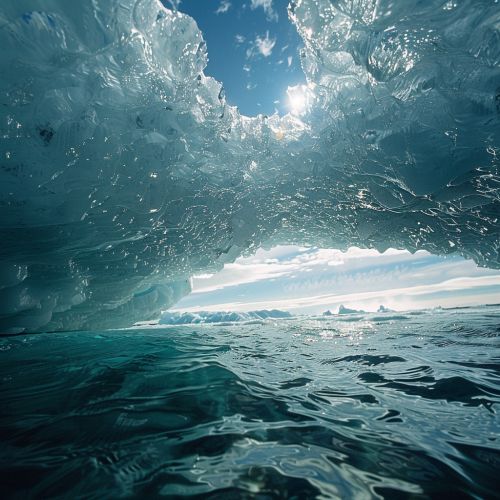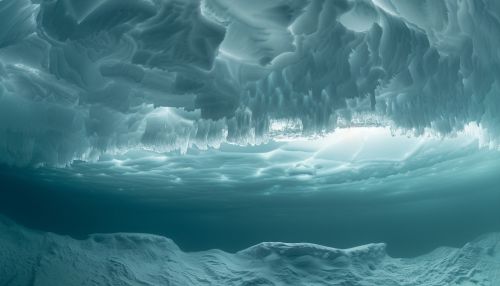Marine ice
Overview
Marine ice is a type of ice that forms at the base of ice shelves in the polar regions of the Earth. It is formed when ocean water freezes onto the base of the ice shelf, a process known as basal freezing. Unlike sea ice, which forms on the surface of the ocean, marine ice forms under the ice shelves, which are extensions of glaciers and ice sheets that float on the ocean.


Formation
Marine ice formation is a complex process that involves several stages. The initial stage involves the freezing of seawater onto the base of the ice shelf. This occurs when the temperature of the water is below the freezing point, which is often the case in the polar regions. The freezing process is facilitated by the pressure exerted by the overlying ice shelf, which lowers the freezing point of the water.
The next stage involves the incorporation of brine pockets into the forming ice. Brine is a solution of salt in water, and it is denser than pure water. As the seawater freezes, the salt is excluded from the ice crystals, forming brine pockets. These pockets are initially trapped within the ice, but over time, they can drain out, leaving behind pure ice.
The final stage involves the compaction of the ice under the weight of the overlying ice shelf. This compaction process can lead to the formation of ice structures such as ice ridges and ice keels, which are characteristic features of marine ice.
Characteristics
Marine ice differs from other types of ice in several ways. One of the most notable differences is its high salinity. While sea ice and freshwater ice have low salinity, marine ice has a high salt content due to the incorporation of brine pockets during its formation. This high salinity makes marine ice denser and harder than other types of ice.
Another characteristic of marine ice is its color. Unlike the white or blue color of sea ice and freshwater ice, marine ice is often green or brown. This is due to the presence of microorganisms and sediments that are incorporated into the ice during its formation.
Marine ice also has a unique crystal structure. While sea ice and freshwater ice have a granular structure, marine ice has a columnar structure. This is due to the slow and steady freezing process, which allows the ice crystals to grow in a vertical direction.
Role in Climate System
Marine ice plays a crucial role in the Earth's climate system. It acts as a barrier between the ocean and the atmosphere, preventing the exchange of heat and gases. This helps to regulate the temperature of the Earth's surface and the composition of the atmosphere.
Marine ice also influences the circulation of ocean currents. The formation of marine ice leads to the release of salt into the ocean, increasing its density. This dense water sinks to the bottom of the ocean, driving the thermohaline circulation, which is a major component of the global climate system.
In addition, marine ice contributes to the stability of ice shelves. The formation of marine ice at the base of the ice shelves helps to counteract the melting of ice from the top and sides of the shelves. This helps to maintain the balance of the ice shelves and prevent their collapse, which could lead to a rise in sea level.
Research and Study
The study of marine ice is a relatively new field of research. It is challenging due to the remote and harsh conditions of the polar regions, as well as the difficulty in accessing the base of the ice shelves. However, advances in technology, such as remote sensing and underwater gliders, have made it possible to collect data on marine ice.
Research on marine ice is important for understanding the dynamics of ice shelves and their response to climate change. It can also provide insights into the history of the Earth's climate, as the composition and structure of marine ice can record past changes in ocean conditions.
